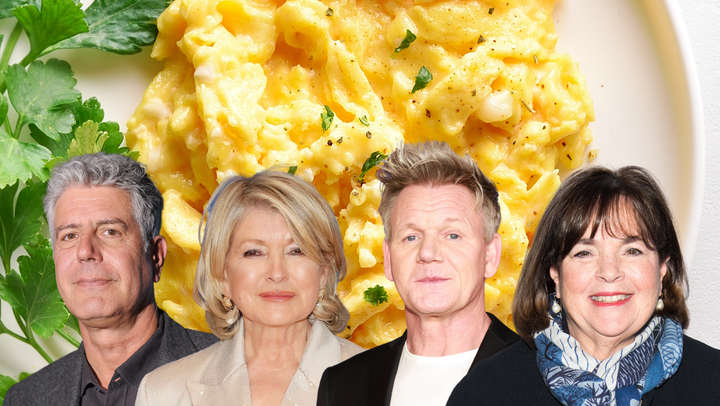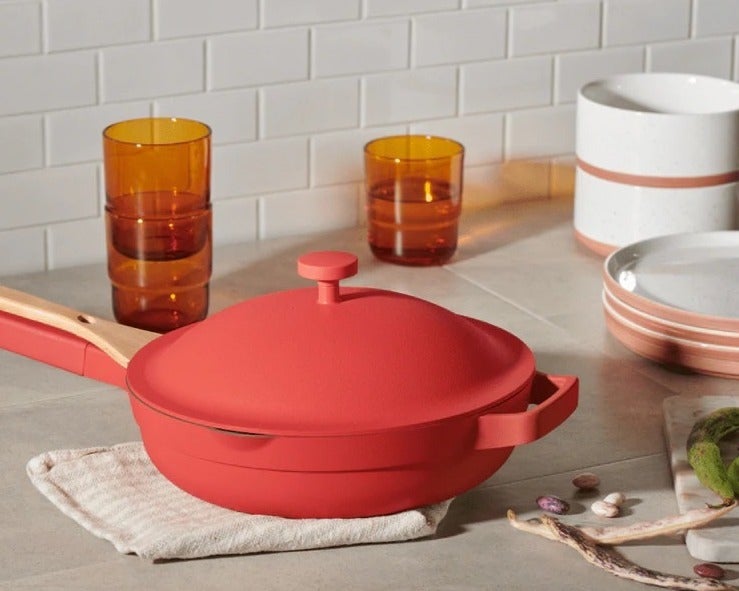
Scrambled eggs have a reputation as a “beginner” dish that’s easy for inexperienced home cooks to make ― but anyone who’s ever ended up with a scorched breakfast can tell you they require some skill and nuance to pull off successfully.
That’s why a Google search for “how to make scrambled eggs” pulls up over 68 million results, including several recipes written by celebrity chefs. But which of these famous gourmets’ methods produce flavorful, fluffy and easy-to-execute scrambled eggs? And which aren’t all they’re cracked up to be? (Pun very much intended.)
We asked a group of professional chefs to weigh in on scrambled egg recipes from Gordon Ramsay, Ina Garten, Anthony Bourdain and Martha Stewart, and here’s their verdict on each one.
Gordon Ramsay
Star English chef Gordon Ramsay (best known for his Michelin-starred restaurants in the U.K. and his TV appearances on “Hell’s Kitchen,” “Kitchen Nightmares” and “MasterChef”) has a very famous ― and very controversial ― technique for scrambled eggs. First, he cracks eggs into a cold skillet without whisking first. Then, he adds butter. Then, he cranks up the heat to high and stirs continuously with a rubber spatula for 30 seconds. He then takes the pan off the heat, stirs for 10 seconds, then puts it back on the heat for 30 seconds. He repeats this process for 3 minutes, then stirs a tablespoon of creme fraiche into the eggs before plating.
The Good: According to Gabriel Glasier, executive chef and founder of Chef Travel Guide, “This recipe produces rich and luxurious scrambled eggs that are elevated to special-occasion status.” Jeff Allen, executive chef of Millers All Day in Charleston, South Carolina, also thinks Ramsay’s recipe makes for very special eggs, largely thanks to the creme fraiche, which “makes the scramble creamy and fluffy.” As for Christina McKeough, chef de cuisine of High Street Philly in Philadelphia, she applauds the clear instructions provided by Ramsay: “Ramsay’s recipe was so concise, detailed and effective in creating that elusive, creamy, luscious texture with very little effort.”
The Bad: While Ramsay’s recipe isn’t necessarily difficult or work-intensive, Glasier does say it’s “how busy restaurant chefs make scrambled eggs. It takes practice and is not good for beginners.” The major variables here are the fact that you’re cracking the eggs right into the pan without whisking (which means that you need to be very consistent with your stirring throughout the cooking process) and, most of all, the use of high heat. “Over high heat, your eggs are very likely to stick and burn,” Allen warned. Finally, because Ramsay’s recipe requires you to move the pan on and off the burner numerous times, there’s a lot of room for error.
The Verdict: Ramsay’s scrambled eggs will give you a rich and luxurious flavor and texture, and they’re ideal for fancy brunch celebrations. That said, our experts question its practicality for beginner chefs, so it’s best to try this one out when you have plenty of free time and plenty of supplies for re-dos.
Ina Garten
Garten, the Hamptons-based culinary doyenne whose “Barefoot Contessa” specialty store spawned a hit Food Network show, takes a holistic approach with her scrambled eggs recipe, offering up both the egg recipe itself and suggestions for how to turn it into a complete meal. Garten whisks her eggs with half-and-half, salt and pepper, then transfers the whisked eggs to a skillet with melted butter over low heat. She then makes the somewhat surprising choice to leave the eggs in place for 3-5 minutes without stirring them. Once the eggs have set, she uses a spatula to fold the fully cooked bottom over the looser top and stirs quickly until the eggs reach a custardy texture. She then pulls the pan off the heat and finishes the cooking process by stirring truffle butter into the eggs. She serves her scrambled eggs by spreading them on toast and garnishing with chopped chives.
The Good: Erik Leong, executive chef of Mahina & Sun’s in Honolulu, thinks the fact that Garten is “a self-trained cook” gives her recipe a level of accessibility, since she understands firsthand how to provide “guidance for the everyday amateur cook.” In terms of Garten’s method, Parkes Brittain, executive chef and partner at Egghill in Nashville, Tennessee, applauds her low-and-slow cooking technique. “Low heat, measured seasoning and the added truffle butter give you more control and help ensure that the final product is going to be consistent and flavorful every time you make it,” Brittain said. Christina Ferrari, chef-owner of Shoreline Lake Boathouse & American Bistro in Mountain View, California, also feels that Garten’s use of low heat makes her recipe very manageable for home cooks: “Ina Garten’s recipe lets you can more easily control the cooking process over low heat, then finishing it off the heat.” Also, Garten’s instructions cover the plating and serving of her eggs, so this one recipe will give you guidance for an entire brunch spread.
The Bad: Garten’s choice to leave her scrambled eggs in place for several minutes can be a tricky one for restless cooks, as the temptation to stir and scrape can quickly become overwhelming. Also, Brittain points out that Garten’s add-ons (the toast, the half-and-half, the truffle butter) can veer in the direction of gilding the lily: “Without considering the added cost of things like cream and truffles, at the end of the day, I want my scrambled eggs to taste like the aforementioned eggs.”
The Verdict: If you’re looking for simple, straightforward, salt-of-the-earth scrambled eggs, Garten’s recipe probably isn’t for you. But if a luxurious breakfast packed with flavor sounds like a great way to start off your weekend, then give this user-friendly recipe a try.
Anthony Bourdain
Bourdain was beloved for his direct and candid communication style, and his no-BS philosophy carries over into his scrambled egg recipe. His method begins with cracking the eggs on a flat surface and then putting the yolks and whites into a bowl with salt and pepper (but no additional cream, milk, water or any other liquid). Next, you beat the eggs, then transfer them to a hot pan (he said to get the pan “not too terribly hot, but hot,” so medium-high heat is a good bet here) with a pat of foaming butter in it. Leave the eggs in place for a minute or so to settle, then begin to move the eggs in a figure-eight formation with a rubber spatula, which he said will create an appealing texture. You can stop pushing the eggs when you have “something fluffy, airy, rippled, with a nice textural note when you taste the egg,” he said.
The Good: Private chef and “Chopped” champion Julia Chebotar loves the straightforward nature of Bourdain’s method, telling HuffPost that “he makes it very simple and no-fuss ― nothing but eggs, butter, pan and a spatula.” Executive chef Joe Mosconi of Venteux in Chicago, agrees, adding that “it’s a great introductory recipe if you’re looking to learn to make straight-up scrambled eggs. Without any extra fillers, the home cook can really learn how eggs behave under heat, and from that baseline, they can start experimenting with additional ingredients.” For Richard Sandoval, chef-owner of Richard Sandoval Hospitality, Bourdain’s figure-eight stirring pattern is a smart move, because “it can help prevent overcooking.”
The Bad: Bourdain’s recipe calls for cooking the eggs in “foaming butter,” but Chebotar warns that this “is a hard technique when you can’t gauge the proper heat of the pan. If it’s too hot, the butter will burn and your eggs will not taste right. If you add eggs to the pan too soon before the butter foams, you might have eggs that stick to your pan.” Also, Bourdain’s recipe isn’t so much a “recipe” as it is a technique; you won’t find specific measurements, cook times, or temperatures here. For that reason, this could prove a challenging endeavor for a beginner home cook.
The Verdict: Bourdain’s method delivers simple, no-nonsense scrambled eggs that can be zhuzhed up with additional ingredients, but are also delicious as is. But because his “recipe” lacks specifics, it might not work for a home cook who doesn’t already have scrambled-egg-making experience.
Martha Stewart
Stewart offers up a scrambled egg recipe that comes with serving tips, thus setting you up for a well-rounded brunch (much as Garten’s recipe does). Stewart starts by thoroughly whisking her eggs with just salt and pepper (no added milk, cream or water). Then, she adds clarified butter to a nonstick skillet over medium heat. She pours the whisked eggs into the pan and uses a silicone spatula to stir for 2 minutes, or until large curds form. Once the curds begin to set, she scoops the eggs onto toasted English muffins (with bacon and asparagus on the side) on a pre-heated plate and sprinkles them with salt and pepper.
The Good: Glasier approves of using clarified butter, saying “it helps with preventing the eggs from turning brown, which is the perfect way to ruin your eggs.” (Clarified butter doesn’t contain milk solids, which can burn.) He also views Stewart’s choice to warm her plates in advance as “a nice touch.” Allen thinks Stewart structures her recipe in a very reader-friendly format: “The biggest strength of the Martha Stewart recipe is the provided details. The recipe does a great job of explaining each step and which tools and ingredients are needed for each step; it really makes this recipe accessible to cooks of all levels.” And Kate Williams, chef-owner of Karl’s in Detroit, vouches for Stewart’s decision to pull the eggs from the pan as soon as the curds start to set, explaining that “the key is to juuuuust undercook them to your liking, as they’ll firm up in those few seconds from pan to plate to mouth.”
The Bad: Glasier likes Stewart’s choice to season with salt and pepper both after whisking and after cooking, but he says that this “can go very badly if the cook does not taste the eggs before the second addition.” Allen feels that Stewart’s recipe would benefit from the addition of “extra dairy, which is needed to make the eggs nice and fluffy.” Williams questions the practicality of using clarified butter, which “I don’t stock at home, and I’m not sure how many home cooks do.”
The Verdict: Overall, Stewart’s scrambled eggs are a great choice for home cooks looking for a well-explained recipe that yields tasty results. That said, the devil is in the details with this version, so you’ll need to pay very close attention to your seasonings and may need to plan ahead if you don’t keep clarified butter on hand.
